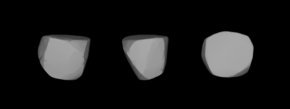68 Leto
 A three-dimensional model of 68 Leto based on its light curve. | |
| Discovery | |
|---|---|
| Discovered by | Karl Theodor Robert Luther |
| Discovery date | 29 April 1861 |
| Designations | |
| (68) Leto | |
| Pronunciation | /ˈlɛtoʊ/[1] |
Named after | Λητώ Lētō |
| Main belt | |
| Adjectives | Letoian /liːˈtoʊ.iən/[2][3] |
| Orbital characteristics[4] | |
| Epoch 31 July 2016 (JD 2457600.5) | |
| Uncertainty parameter 0 | |
| Observation arc | 152.08 yr (55548 d) |
| Aphelion | 3.30153 AU (493.902 Gm) |
| Perihelion | 2.26072 AU (338.199 Gm) |
| 2.78112 AU (416.050 Gm) | |
| Eccentricity | 0.18712 |
| 4.64 yr (1,694.1 d) | |
| 48.7204° | |
| 0° 12m 45.025s / day | |
| Inclination | 7.97189° |
| 44.1270° | |
| 304.826° | |
| Physical characteristics | |
| Dimensions | 122.57±5.3 km[4] 124.96±6.42 km[5] |
| Mass | (3.28±1.90)×1018 kg[5] |
Mean density | 3.21±1.92 g/cm3[5] |
| 14.848 h (0.6187 d) | |
| 0.2283±0.021[4] 0.228[6] | |
| S | |
| 9.56 (brightest) | |
| 6.78 | |
68 Leto is a large main belt asteroid that is orbiting the Sun. The asteroid was discovered by German astronomer Robert Luther on April 29, 1861, and is named after Leto, the mother of Apollo and Artemis in Greek mythology. It orbits at a distance of 2.78112 AU over 4.64 years and has an orbital eccentricity of 0.187. The orbital plane is inclined at an angle of 7.97° to the ecliptic.[4]
Photometric observations of 68 Leto during 1997 provided a rotation period of 14.856 ± 0.024 h.[7] It has an estimated cross-sectional size of 123 km. The spectral type is S, suggesting a stony, silicate composition.
References
- ^ "Leto". Lexico UK English Dictionary. Oxford University Press. Archived from the original on 22 March 2020.
- ^ E. Alan Roberts (2013) The Courage of Innocence: (The Virgin of Phileros), p. 191
- ^ Greek Λητῷος – Lētōi-os. Liddell, Henry George; Scott, Robert; A Greek–English Lexicon at the Perseus Project
- ^ a b c d "68 Leto". JPL Small-Body Database. NASA/Jet Propulsion Laboratory. Retrieved 12 May 2016.
- ^ a b c Carry, B. (December 2012), "Density of asteroids", Planetary and Space Science, 73 (1): 98–118, arXiv:1203.4336, Bibcode:2012P&SS...73...98C, doi:10.1016/j.pss.2012.03.009, S2CID 119226456. See Table 1.
- ^ "Asteroid Data Sets". Archived from the original on 17 December 2009. Retrieved 13 January 2007.
- ^ López-González, M. J.; Rodríguez, E. (September 2005), "Lightcurves and poles of seven asteroids", Planetary and Space Science, 53 (11): 1147–1165, Bibcode:2005P&SS...53.1147L, doi:10.1016/j.pss.2005.04.010
External links
- 68 Leto at AstDyS-2, Asteroids—Dynamic Site
- 68 Leto at the JPL Small-Body Database
